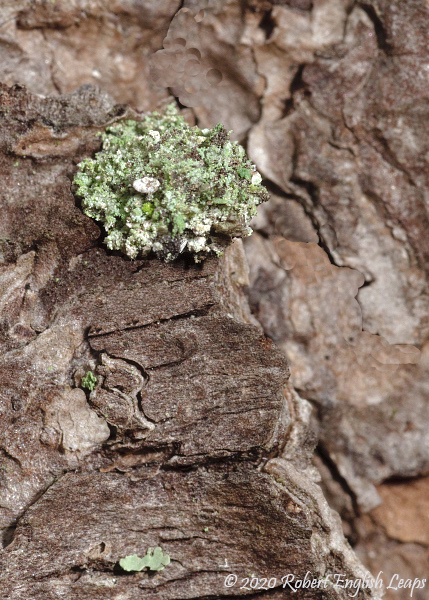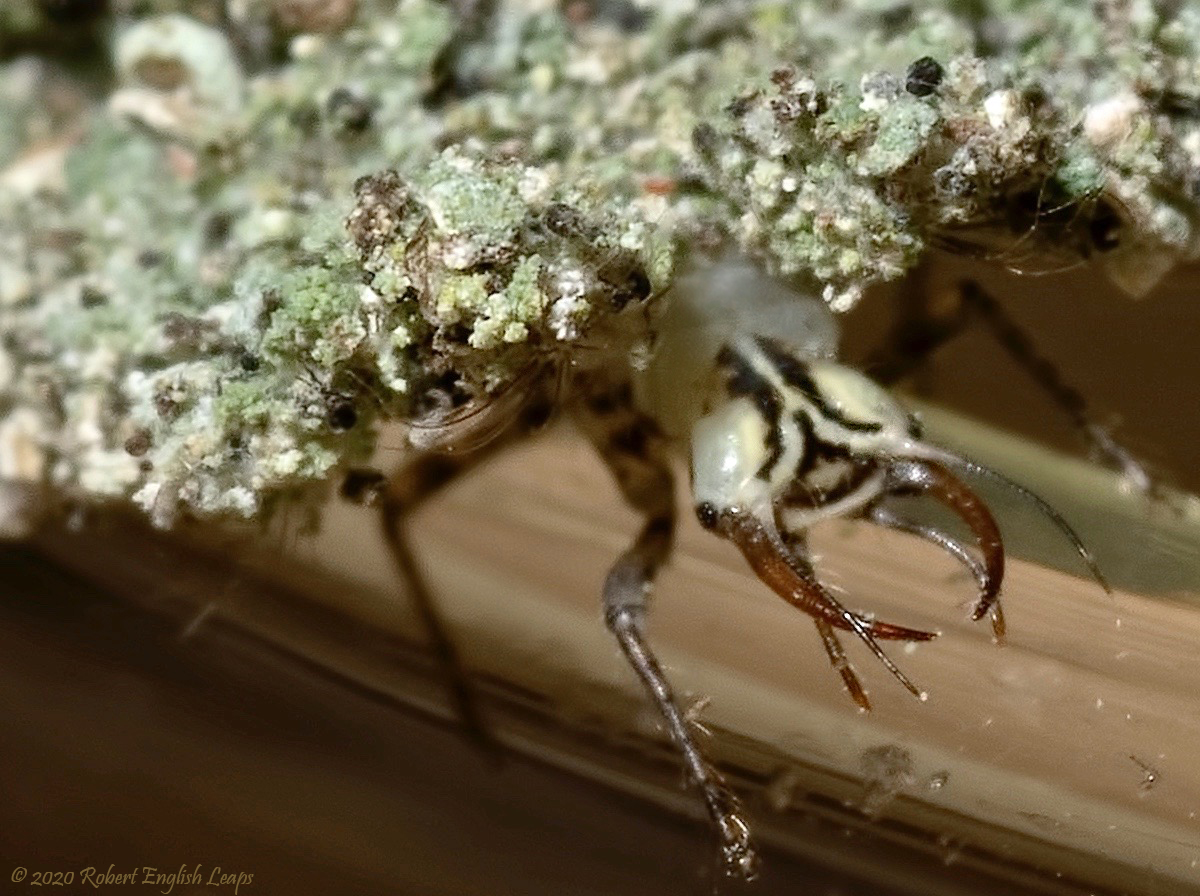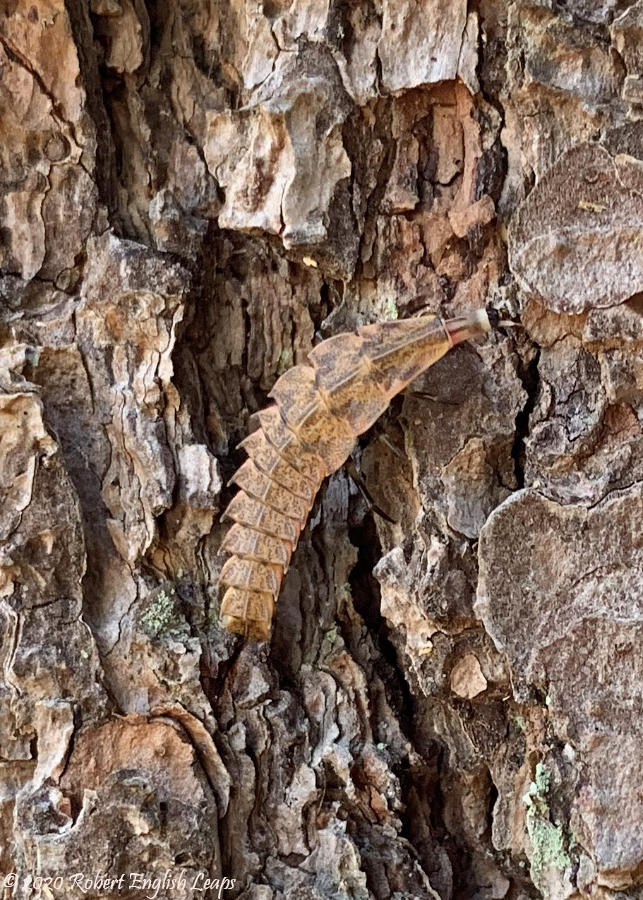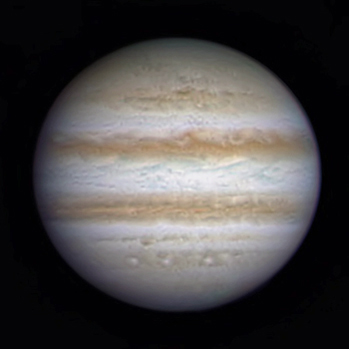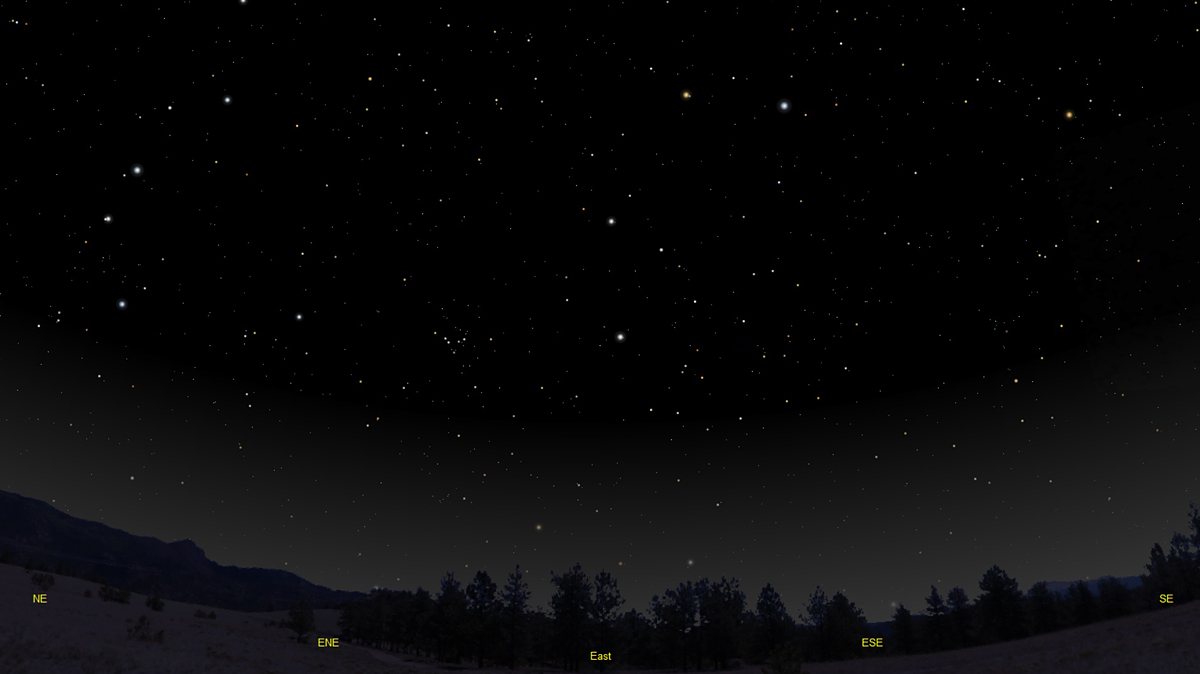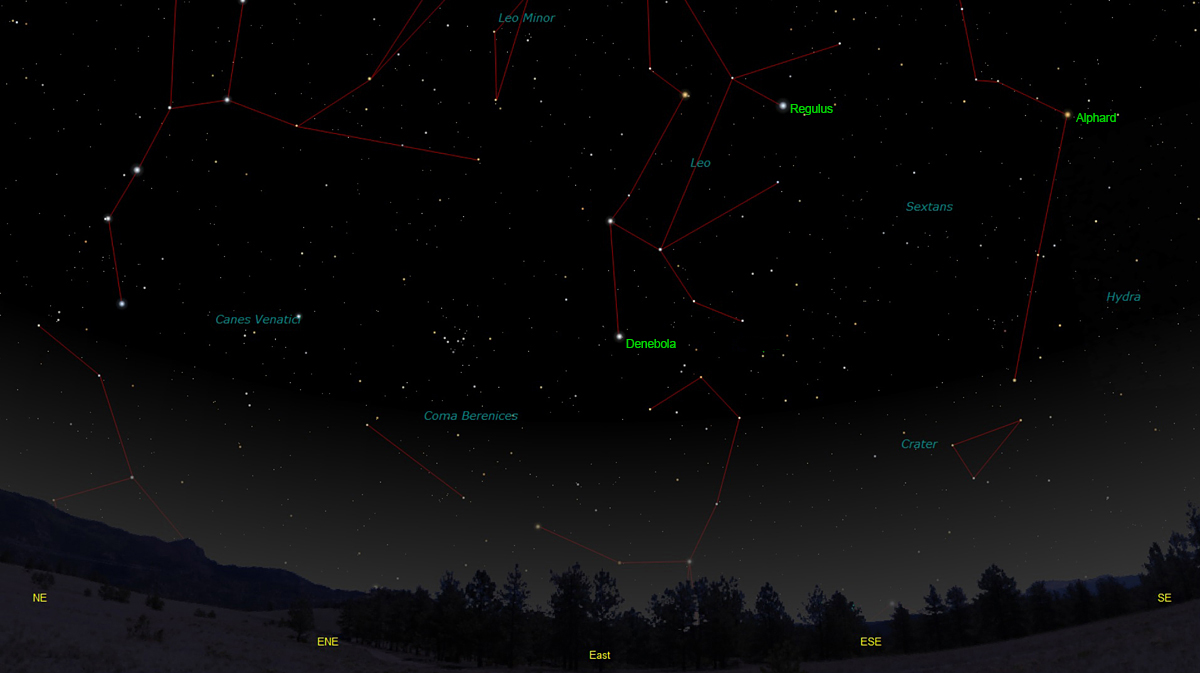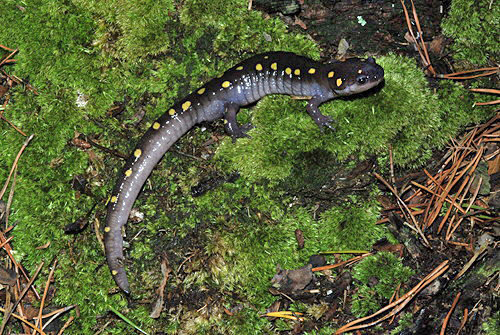The purpose of this feature is to give scout leaders, educators and naturalists an idea of some of the natural events coming up each month. We will try to cover a variety of natural events ranging from sky events to calling periods of amphibians, bird and mammal watching tips, prominent wildflowers and anything else that comes to mind. We will also note prominent constellations appearing over the eastern horizon at mid-evening each month for our area for those who would like to learn the constellations. If you have suggestions for other types of natural information you would like to see added to this calendar, let us know! Note: You can click on the hyperlinks to learn more about some of the featured items. To return to the Calendar, hit the "back" button on your browser, NOT the "back" button on the web page. All charts are available in a "printer friendly" mode, with black stars on a white background. Left clicking on each chart will take you to a printable black and white image. Though we link book references to nationwide sources, we encourage you to support your local book store whenever possible.
Notes From January 2020 "That piece of lichen is moving!" I was running a moth route with a friend one evening and I spotted a small piece of lichen that appeared to come alive and slowly make its way across the trunk of a pine. We knew we were looking at some sort of insect, but it took a little sleuthing to find that we were looking at the larval stage of a Green Lacewing.
There are three types of metamorphosis in insects. Some insects have little or no change in appearance from egg to adult. They grow and molt but do not change in appearance. They experience no real metamorphosis and are referred to as "ametabolous." The second type of metamorphosis is referred to as gradual or incomplete metamorphosis. From the egg these insects go through several nymph stages and gradually grow to take on the appearance of an adult. These insects are referred to as "hemimetabolous." The third type of metamorphosis is complete metamorphosis. From the egg the young go through a larval stage, then form a pupa and exit the pupa as fully formed adults. The larvae of these insects, referred to as "holometabolous," bear no resemblance to the adult. The Green Lacewing undergoes complete metamorphosis. The lacewing larvae, sometimes called aphid lions, are so small and well camouflaged that they are hard to spot when not moving. The look a lot like a small patch of lichen on the tree bark. The one shown at right is about a quarter of an inch in diameter. The larva takes debris and places it on its back. At least some of this debris are the remains of its unfortunate victims. The back has a number of net-like support structures that keep this clever camouflage in place. You can see some of this support network in the image below. They are quite common, even in the winter months, and it's fun to see if you can spot one. We were most successful on large, lichen-covered conifers. We found several on January 18th. We find that to spot the larvae it helps to have the right search image. The debris on their backs has a different texture than the surface of the lichens. The larvae are conspicuously circular in shape compared to the irregular shapes of the lichen. Their bodies are thicker than the lichen. If you touch them gently with a pine needle, they feel soft. They tend to be around a quarter of an inch in diameter. It may take a while to find your first one, but it becomes easier with practice. I wanted to get a portrait, but every time I tried for a close-up of its head something blocked my view. It was like one of those British whodunits where you keep seeing glimpses of the murderer, but something always hides their face. We finally took it inside. As it warmed up the larva became more active. I finally got a few sharp images. On very small creatures you don't really see all the details when you take the images. The full detail is seen only when you zoom in on the images. I love that aspect of macro photography. You enter another world, and you never quite know what to expect. What I saw was a fearsome predator! The long pinchers are hollow and are used to empty the bodies of its soft-bodied prey. The head of the one below was less than 1/16th of an inch across. After we got a few shots we returned it to its home.
The lacewing larvae feed on aphids, fly larvae and other similar creatures, and so are a highly beneficial insect to have in a garden. Adult lacewings have typanal organs at the base of the forewing. Some species can hear a bat's ultrasound calls, and take evasive action, closing their wings and dropping to the ground when a bat is nearby. Some can also generate very low frequency sounds by vibrating their abdomen. These sounds are involved in courtship, and are around 60 hz and delivered once per second to once every few seconds, depending on the species. Tap or double click the sonograms to hear the calls. It's eerie to hear a sound this low coming from such a small insect! There are 87 species of Green Lacewings in the United States and Canada.
It seems strange to be observing firefly larvae in January! This species, nicknamed the Spring Treetop Flasher by Lynn Faust in her book "Fireflies, Glow-worms and Lightning Bugs," is the first species of firefly in Tennessee to begin flashing in the spring. It is quite tolerant of cold temperatures. According to Faust, the larvae are surface hunters in their early instars and as early as January they begin to climb "colony" trees where they will eventually pupate. These colony trees may be used year after year. Faust says the larvae and pupae are often found from 3 feet to 10 feet off the ground on the south side of large diameter trees. My larva was indeed about 3 feet off the ground on the south side of the tree. It will eventually pupate in late February and early March. It's important not to disturb the vulnerable pupae. When the adults emerge from their pupa they climb to the top of the tree to begin their courtship from the still leafless branches. Most of us who grew up in the south are familiar with the basics of firefly courtship and how those softly glowing lights in the dark are the courtship signals of each species. But Faust's book takes everything to a new level. You find out quickly just how much you have to learn about these amazing creatures. To me Faust's book is analogous to the first bird guides that delivered us from the "birding by shotgun" days. It has firefly lore, detailed species accounts and natural history, and useful tips for field identification. There are charts that show the flash pattern of each species. I highly recommend getting this book now, and using it to become familiar with each species as they introduce themselves this year.
Sky Events for February 2020:
Morning Sky: Mars begins the month in Ophiuchus, rising around 4:18am in the southeastern sky before sunrise. It will be below and to the left of the bright star Antares in Scorpius. Antares, whose name means, "Rival of Mars," is about the same brightness as Mars but should twinkle more. The red planet will move into Sagittarius later in the month. It's still tiny in a telescope's field of view, with an apparent diameter of just over 5 arc seconds. Jupiter rises about an hour and a half before the Sun and begins the month in Sagittarius. Waiting till just before dawn will give the best view telescopically. Saturn rises after Jupiter, about 50 minutes before sunrise. It also is in Sagittarius this month.
Evening Sky: Venus is the first star like object to appear in the southwestern sky after sunset. As the month goes on it will appear higher and higher above the horizon each evening. It will reach maximum elongation from the Sun in late March. Mercury reaches greatest elongation from the Sun on February 10th. Begin looking for it about 30 to 40 minutes after sunset low in the south-southwestern the sky. It should be visible for the next week or so, before it fades into the evening twilight. It helps to have a clear flat southwestern horizon.
The views below show the sky looking east at 10:00pm EST on February 15th. The first view shows the sky with the constellations outlined and names depicted. Star and planet names are in green. Constellation names are in blue. The second view shows the same scene without labels. Ursa Major, the Great Bear, is now prominent in the northeast. All of the bright stars of Leo, the Lion, are visible now, including Denebola, the bright star at the tip of the Lion's tail. Part of the constellation of Virgo is visible below Leo. It's handy to know where Denebola is, because below it, if you imagine sliding down the Lion's tail, is the great Virgo cluster of galaxies. Left of Denebola, on a line towards the handle end of the "big dipper," you will see the faint star cluster Mellotte 111, in Coma Berenices. With a telescope, you can star hop or use a go-to mounting to find the barred spiral galaxy M91. The faint constellation of Crater has now cleared the horizon.On Learning the Constellations: We advise learning a few constellations each month, and then following them through the seasons. Once you associate a particular constellation coming over the eastern horizon at a certain time of year, you may start thinking about it like an old friend, looking forward to its arrival each season. The stars in the evening scene above, for instance, will always be in the same place relative to the horizon at the same time and date each February. In particular, learn the brightest stars (like Regulus and Denebola in the above scene), for they will guide you to the fainter stars. Once you can locate the more prominent constellations, you can "branch out" to other constellations around them. It may take you a little while to get a sense of scale, to translate what you see on the computer screen or what you see on the page of a book to what you see in the sky. Look for patterns, like the stars of Leo. The earth's rotation causes the constellations to appear to move across the sky just as the Sun and the Moon appear to do. If you go outside earlier than the time shown on the charts, the constellations will be lower to the eastern horizon. If you observe later, they will have climbed higher. As each season progresses, the earth's motion around the sun causes the constellations to appear a little farther towards the west each night for any given time of night. If you want to see where the constellations in the above figures will be on March 15th at 10:00pm EST, you can stay up till 12:00am EST on the February 16th and get a preview. The westward motion of the constellations is equivalent to two hours per month. Recommended: Sky & Telescope's Pocket Star Atlas is beautiful, compact star atlas. A good book to learn the constellations is Patterns in the Sky, by Hewitt-White. You may also want to check out at H. A. Rey's classic, The Stars, A New Way to See Them. For sky watching tips, an inexpensive good guide is Secrets of Stargazing, by Becky Ramotowski.
A good general reference book on astronomy is the Peterson
Field Guide,
A Field Guide to the Stars and Planets, by Pasachoff. The book retails for around $14.00.
The Virtual Moon Atlas is a terrific way to learn the surface features of the Moon. And it's free software. You can download the Virtual Moon Atlas here. Apps: We really love the Sky Safari 6 Pro. It is available for both iOS and Android operating systems. There are three versions. The Pro is simply the best astronomy app we've ever seen. The description of the Pro version reads, "includes over 100 million stars, 3 million galaxies down to 18th magnitude, and 750,000 solar system objects; including every comet and asteroid ever discovered." A nother great app is the Photographer's Ephemeris. Great for finding sunrise, moonrise, sunset and moonset times and the precise place on the horizon that the event will occur. Invaluable not only for planning photographs, but also nice to plan an outing to watch the full moon rise. Available for both androids and iOS operating systems.
Amphibians:
Recommended: The Frogs and Toads of North America, Lang Elliott, Houghton Mifflin Co. Archives (Remember to use the back button on your browser, NOT the back button on the web page!) Natural Calendar December 2019 Natural Calendar November 2019 Natural Calendar September 2019 Natural Calendar February 2019 Natural Calendar December 2018 Natural Calendar November 2018 Natural Calendar February 2018 Natural Calendar December 2017 Natural Calendar November 2017 Natural Calendar October 2017Natural Calendar September 2017 Natural Calendar February 2017 Natural Calendar December 2016 Natural Calendar November 2016 Natural Calendar September 2016Natural Calendar February 2016 Natural Calendar December 2015 Natural Calendar November 2015 Natural Calendar September 2015 Natural Calendar November 2014 Natural Calendar September 2014 Natural Calendar September 2013 Natural Calendar December 2012 Natural Calendar November 2012 Natural Calendar September 2012 Natural Calendar February 2012 Natural Calendar December 2011 Natural Calendar November 2011 Natural Calendar September 2011 Natural Calendar December 2010 Natural Calendar November 2010 Natural Calendar September 2010 Natural Calendar February 2010 Natural Calendar December 2009 Natural Calendar November 2009 Natural Calendar September 2009 Natural Calendar February 2009 Natural Calendar December 2008 Natural Calendar November 2008 Natural Calendar September 2008 Natural Calendar February 2008 Natural Calendar December 2007 Natural Calendar November 2007 Natural Calendar September 2007 Natural Calendar February 2007 Natural Calendar December 2006 Natural Calendar November 2006 Natural Calendar September 2006 Natural Calendar February 2006
Natural Calendar December 2005
Natural Calendar November 2005
Natural Calendar September 2005
Natural Calendar February 2005
Natural Calendar December 2004
Natural Calendar November 2004
Natural Calendar September 2004
Natural Calendar February 2004
Natural Calendar December 2003
Natural Calendar November 2003 Natural Calendar February 2003 Natural Calendar December 2002 Natural Calendar November 2002 Nature Notes Archives: Nature Notes was a page we published in 2001 and 2002 containing our observations about everything from the northern lights display of November 2001 to frog and salamander egg masses. Night scenes prepared with The Sky Professional from Software Bisque All images and recordings © 2020 Leaps
|
|
